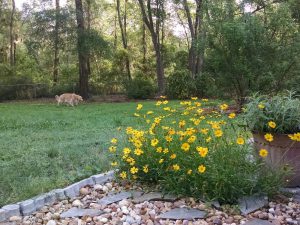Free Nutrients:
My oak trees have been dropping leaves like crazy this fall and winter. WooHoo, free nutrients for my planted shrubs and perennials. I created large plant beads so the leaves can drop in and provide a mulch layer that decomposes supplying an organic nutrients source to my plants. It cuts down on the amount of hardwood mulch I buy and saves me a lot of labor!
Benefits:
Organic mulch can improve soils organic matter. I am amazed at the number of earth worms that hang out in my mulched plant beds. My soil is so dark and rich in these areas, I almost forget that Florida has mostly sandy soils. Other benefits of mulch include buffering soil temperatures. It keeps plant roots cooler in the summer and warmer in the winter. My dogs have figured out that they can scratch away mulch and find a cool place to watch the world go by during the heat of summer. Mulch also slows moisture evaporation and reduces the water needs of plants. When applied to a depth of 3″-4″, mulch can help shade out weeds. It also helps reduce soil erosion. Lastly, it can protect plants. It can prevent certain plant diseases and help keep mowers and string trimmers from being used to close to plants and trees.

Types of Mulch:
You can mulch with leaves, pine bark, mixed hardwood, melaleuca, eucalyptus, utility and pine straw. Or you can use in-organic mulches such as gravel, and river rock. One thing to avoid with mulch is piling it up on the tree trunk or plant. That is called volcano mulching and can keep the bark too wet or provide habitat for rodents to chew tender bark and can ultimately kill the tree.
How Much and When:
If buying bagged mulch, one cubic foot will cover four square feet to a depth of 3″. Beat the weed seeds and summer heat by spreading your mulch now.
 0
0
